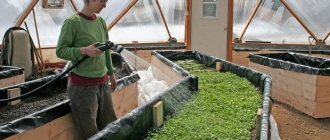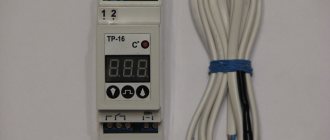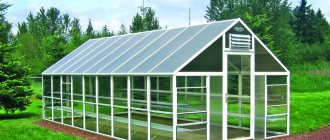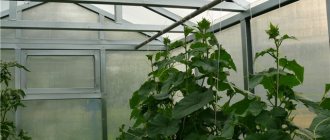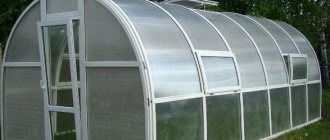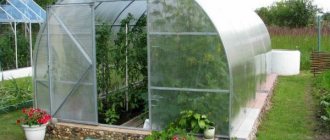SO WHERE IS THE ROOM FOR A WINDOW IN A GREENHOUSE?
Only then will the flowers of your tomatoes be pollinated and the formation of ovaries will occur if the optimal temperature is maintained in the greenhouse installed on your site to keep the pollen dry. You may have seen something like this. One gardener’s tomato bushes in the greenhouse are bursting with harvest, while for another, the same varieties of tomatoes do not bear fruit or produce a very low yield. But the fact is that the greenhouses of these two owners were built completely differently. One greenhouse - taking into account all the rules for constructing greenhouses, and the second is an amateur one - without windows, so that no draft “freezes” the plants.
The fact is that at high temperatures, pollen becomes sterile, and the moisture in the air settles on the plants, while the pollen in the flowers is greatly moistened. As a result, normal pollination of flowers and formation of fruit ovaries does not occur. Therefore, on a hot sunny day, a homemade amateur greenhouse often does more harm to plants than good, and the larger the structure, the more problems.
On such days, the air temperature inside the greenhouse, especially in its upper part, can reach 40-50 degrees, while the air humidity drops sharply. Such conditions usually occur in the desert and are more suitable for cacti, but not for those from the humid tropics. At the same time, the leaves and young shoots of the plants wither, and the flowers and ovaries fall off.
Each gardener himself tries to find a way out of this situation, based on his experience and capabilities. Some try to constantly live in the garden at this time, if necessary, constantly opening or closing all the doors and windows. Others resort to various tricks - whitening or covering glass with translucent materials, shading plants, using light mulch, etc. And still others install various vents, often in the side wall, less often in the end wall.
For the plant, the best location for the window is as far away from it as possible so that there is no cold draft, but at the same time it must ensure complete removal of heated air from the greenhouse.
To reduce air humidity in the greenhouse, there must be sufficiently sized vents every 2 m along its entire perimeter. But if the vents are located only on the side wall, then in the upper part of the greenhouse, above the level of the vents, a “cushion” of superheated air is formed, which on hot sunny days literally “fries” the tops of the plants.
The simplest and most affordable way to get rid of high temperature and humidity in a greenhouse is to make opening transoms in the very top part of the greenhouse in addition to the vents on the side walls on both ends of the greenhouse. This will provide fairly good ventilation, and, therefore, improve conditions for pollination of flowers and formation of ovaries.
But the best option from the point of view of the efficiency of removing superheated air is to make vents in the roof, preferably in the very top part of it - at the ridge, which should open not at the bottom, but at the top, that is, the ridge of the greenhouse itself should rise. Such a transom should be made narrow, but longer, as this will create ideal conditions for ventilating the greenhouse. Moreover, their desired size should be at least 10% of the greenhouse area.
This arrangement of vents in the greenhouse will completely solve all temperature problems and ensure very high fruit set on the plants. At the same time, such transoms will protect plants from most diseases.
Additional side window in the greenhouse
Side windows for a greenhouse - do they need to be installed? As standard, our greenhouses already have two vents located at the ends of the greenhouse on each side. But on particularly hot days, when the temperature can exceed 28-30 degrees, such ventilation is not enough. Therefore, we recommend the use of side windows in the greenhouse, which will help reduce the temperature inside the greenhouse.
Of course, you can use the door to ventilate, but then there is a risk of draft. Also, with a greenhouse length of 6 meters or more, even with the doors open, the temperature in the central part of the greenhouse made of galvanized pipe will be higher than at the doors. Therefore, proper ventilation is the key to a rich harvest.
Ready-made windows: manufacturers, rating of the best and prices
Today there are many manufacturers on the domestic market that offer ready-made solutions for greenhouses of various sizes.
Such structures are reliable, stable and are made taking into account the climate.
Will
Characteristics:
- The basis of the window is a frame made of galvanized metal. The system is assembled using nuts and screws.
- The window covering is cellular polycarbonate.
- Painting: polymer coating.
- Dimensions - 910x500 mm.
- The weight of the window with fittings is 4 kg.
Cost - from 916 rubles.
Innovator
Characteristics:
- Material: profile metal pipe with a diameter of 20x20 mm.
- Painting: polymer coating.
- Dimensions - 930x510 mm.
- The weight of the window with fittings is 4.3 kg.
- The kit includes fittings for fastening and mounting polycarbonate.
Cost - 1,200 rubles.
HRT
Characteristics:
- It is a frame with a lock (handle).
- Material: square metal pipe with a diameter of 20x20 mm (profiled for the roof).
- Size - 970x500.
- The weight of the window with fittings is 2.4 kg.
- The package may include an automatic opening mechanism (purchased separately).
Cost - from 968 rubles.
Neoform
Characteristics:
- The window covering is cellular polycarbonate.
- Painting: polymer coating.
- Dimensions - 910x500 mm.
- The weight of the window with fittings is 4.5 kg.
- The package may include an automatic opener with an additional sash (purchased for an additional fee).
Cost - from 900 rubles.
Very strong
Characteristics:
- The shape is rectangular.
- The window covering is cellular polycarbonate.
- Frame material: galvanized profile pipe 20×20 mm.
Window dimensions:
- The distance between the arcs is 0.5 m - 480x500 m.
- The distance between the arcs is 0.67 m - 645x500 mm.
- The distance between the arcs is 1 m - 980x500 mm.
- If desired, you can purchase an automatic ventilation system.
Cost - from 980 rubles.
Rosteplitsa
Characteristics:
- The design is a frame into which a hinged window is mounted (in the shape of a greenhouse arc).
- The frame is a galvanized metal profile 20x20 mm.
- The window covering is cellular polycarbonate.
- Dimensions - 900x450 mm.
- Rubber compressor.
- The weight of the window with fittings is 4.3 kg.
Cost - from 990 rubles.
Rules for installing side windows in a greenhouse:
The installation of vents always begins on the south side, since this side heats up faster. Installation on the north side is not recommended. In weather when the north wind blows, its cold currents will enter the greenhouse through open ventilation openings and significantly worsen the growing conditions of plants. Installation on the north side is possible if the greenhouse is closed by a fence, house, trees, i.e. no cold air coming in.
Forced ventilation of the greenhouse: we ventilate the room automatically
If the natural way is to ventilate the greenhouse using vents and doors that are opened manually by a person, then forced ventilation is created automatically, using various artificial devices that can operate without human presence.
A fan can create favorable conditions for plant growth not only throughout the entire greenhouse, but also for a separate area. Forced ventilation has its own ventilation options: supply, when cold air, with the help of a fan, enters the greenhouse and exhaust, when the opposite happens, the device pulls moist air from the room. Usually, exhaust and supply fans are installed opposite, then the effect will be better.
There are several ways to automatically ventilate a room:
- Electric;
- Hydraulic;
- Bimetallic;
- Using automatic windows.
The electric method is the most inexpensive; it is popular among many owners of greenhouses and greenhouses. Electric fans can be installed in different places in the greenhouse and are very reliable in operation. The hydraulic method is considered the most durable and easiest to install. You can assemble it very quickly with your own hands. Such a system consists of sensors and levers, with the help of which the system opens and closes. The bimetallic method consists of metal-plastic plates that, when heated, bend and open the windows. This system can only be used for small windows and vents; it will not be able to open large ones. The simplest and most common are automatic vents. They are used by most gardeners and gardeners.
Thermal drive for side vents in a greenhouse makes life easier for summer residents
The thermal drive for ventilating the greenhouse allows the gardener to free his hands. Every gardener knows that ventilation must be carried out regularly. Thanks to this, the temperature and humidity levels in the greenhouse are normalized. The use of automation eliminates the need to control these parameters; then open and close the windows. The drive automatically opens the ventilation frames when the temperature exceeds the established standards, and closes them when the temperature drops. This is especially true for those who appear on their site only on weekends, the owner is not present, and the thermal drive will properly perform its function.
Find out more about our thermal drive by visiting the page - Thermal drive for greenhouse ventilation
In order to obtain a high yield in a greenhouse, it is necessary to ensure proper ventilation. The window will cope well with this task. Such a design must be of high quality and highly efficient. To achieve this result, you should familiarize yourself with the design features of greenhouse vents.
Mounting options
The design of each window necessarily provides for the presence of clamps; they are responsible for the opening angle.
Today the devices are presented in two options.
- Comb. It is a simple element through which the window is fixed in the required position. It is not used in automatic systems because it limits the mechanism, which leads to rapid breakdown.
- Spring on a chain. The automatics are equipped with limiters on a chain with a spring, which protect the system in strong winds.
One of the options for fastening windows is rotary hinges. The choice of what design the phragm will be will not affect the microclimate in any way. If there was no preliminary calculation of the temperature regime, then they do not make a frame; the polycarbonate is cut on three sides and the edge is folded, which should move freely. A stiffening rib is created at the lower level; a rail or profile can be used as it. This design can help out until a ventilation system is organized.
The vents must be vertical, but on the windy side, since a draft negatively affects the humidity level. It is important to maintain natural circulation. If the greenhouse is long or tall crops are planted inside, then the created ventilation system will not work; a different type is required.
You can find out if there are enough windows inside by looking closely at the walls. If condensation is collecting, it's time to upgrade the design.
Peculiarities
Dachas equipped with greenhouses have always pleased their owners with a large harvest. In winter, in polycarbonate greenhouses, the most popular at present, the conditions for keeping plants are optimal. But with increasing solar activity in spring and summer, the situation changes.
Polycarbonate transmits light very well, but at the same time does not allow air to circulate.
The temperature in the greenhouse becomes too high and can have a detrimental effect on the plants grown in it. Therefore, in such a design the window is especially important.
The movable part of the greenhouse intended for ventilation is called a window. This device allows you to create your own microclimate in the greenhouse, which has a beneficial effect on the cultivation of various types of vegetable crops.
The window has the following features:
- prevents the risk of condensation;
- ensures proper movement of air masses;
- eliminates severe overheating of air in the greenhouse during the day;
- minimizes the temperature difference between day and night;
- will allow adaptation of plants before planting in open ground.
A window in a greenhouse will prevent the appearance of woodlice, aphids, slugs, all kinds of pests and bacteria that always appear in warm and humid rooms. Greenhouses in which the indicated conditions are met will delight you with an excellent harvest.
Purpose
A favorable climate can be created in a greenhouse at the dacha only by organizing ventilation. It is not enough to simply install windows; you need to do it correctly, this is the only way to prevent the appearance of microorganisms and bacteria. Forced ventilation of the greenhouse is one of the options.
A good option is polycarbonate, which allows light to pass through, but not air. A window is extremely necessary for cucumbers in winter and other crops. Most often, there are two vents so that the plants inside do not burn from the elevated temperature, but their number depends on the size of the room. Usually they organize the structure on a gable roof and other options.
There are ready-made options, or you can create it yourself using suitable tools. It is the window that contributes to the hardening of planted crops. They become more resistant to adverse conditions.
All ventilation structures can be divided into such large groups as:
- mechanical;
- automatic from shock absorber or hydraulics;
- with opening system.
Automatic polycarbonate windows are equipped with an electric drive. This option is more practical than the mechanical one, since the system reacts to rising temperatures thanks to the installed transom. Thus, the microclimate inside remains at the required level, which simplifies the process of caring for plants for the gardener.
Device
The design of vents in greenhouses may differ in size, location and opening mechanism. The last characteristic is the most significant. To organize good air circulation, it is possible to use natural or forced ventilation.
In a film or glass greenhouse made independently, they usually use the simplest and cheapest way to equip the greenhouse with the correct microclimate - natural ventilation. Natural ventilation involves ensuring air exchange through open doors, windows, and vents. The overheated and humid air of the greenhouse is gradually replaced by fresher outdoor air.
Considering that hot air tends to rise, you should install a window on the roof, and the side position of the door will ensure air flow.
Such ventilation will sufficiently provide good conditions in a small greenhouse, but requires mandatory human control. However, for large greenhouses such ventilation will not be enough.
Location
If you purchase a ready-made greenhouse, it will include drawings where the windows will be located. The designers have already provided for the abundance of precipitation and other factors that should be taken into account in the region. Sometimes a hole is made on the roof, but side ventilation is considered no less effective. Since warm air is concentrated under the ceiling, vents made there are more effective. With a lateral arrangement, the height is approximately divided into three parts and the structure is installed, retreating 2/3 from the ground.
If the window is organized independently, then the following requirements must be taken into account:
- there should be no windows near the entrance;
- the first structure is installed in the middle of the greenhouse;
- best location from the south.
Hydraulic
Automatic opening of the window with a hydraulic drive is reliable. This lever system can be purchased at a store or made yourself.
The principle of operation of the mechanism is based on the ability of liquids to expand when heated. Factory devices consist of a hydraulic cylinder with liquid (paraffin or oil) and a movable rod attached to the window. When the air in the greenhouse is heated, the liquid in the hydraulic cylinder expands and pushes out the rod, which gradually opens the window. The air cools, the liquid narrows and the window closes.
The do-it-yourself system works like communicating vessels.
One of the vessels is located below and acts as a thermostat. It is sealed, half filled with liquid and half with air. Another vessel is located at the top and acts as a weighting agent. The window leaf must be fixed on a rotating central axis. A weighting material is installed on one side of the sash, and a counterweight on the other.
As the temperature in the greenhouse rises, the air in the lower vessel expands and pushes liquid into the upper vessel, and the window opens. When the temperature in the greenhouse drops, the system works in the reverse order and the window closes.
This design can be made using ordinary plastic bottles.
This is the simplest, but at the same time effective automatic window opening system. A minimum of effort and materials are spent to create it.
The disadvantage of this system is that the liquid takes a long time to cool down. In case of sudden cold weather, the window will close for about 20-30 minutes. Hypothermia can be detrimental to cucumbers and other crops that cannot tolerate cold.
Creating a do-it-yourself ventilation system
Automatic ventilation system.
In order to create a mechanism that powers the elements of the system, you must have:
- Drive unit.
- Small sheets of metal.
- Water cylinder.
Mechanism with hydraulic cylinder
The principle of operation is simple - the device is driven by the expansion of liquid collected in a cylinder under the influence of the sun's rays.
As the temperature rises, air pressure forces fluid from one cylinder to another. At the same time, the weight in one container becomes significantly less, and the farm opens. As soon as the temperature drops, the farmhouse closes.
Metal plates
Metal plates expand well at high temperatures.
When this happens, it expands, bends strongly, and at the same time sets the window in the greenhouse in motion:
- To build the mechanism, you will need strips of metal and an inch board.
- Please note that this method is only suitable for opening small windows.
- You need to insert a block between the metal plate and the board. All this is carefully fixed at the very bottom of the greenhouse.
Pneumatic drive
The opening of the window will occur when heated air expands in the drive.
To make the mechanism you will need:
- Piston with foam rod.
- Rubber hose.
- A container for air, preferably made of metal.
- 20 - centimeter cylinder.
- Pulley.
- Durable cord.
- Wooden rocker.
- A ball made of plastisol.
Automatic ventilation of greenhouses with your own hands using a pneumatic drive is not difficult:
- You just need to make sure that the guide for the rod is fixed in the upper part of the cylinder.
- A hole is made in the bottom through which the hose is pulled.
- The mechanism starts working when the balloon is inflated.
- It lifts the rod and piston, which causes tension on the hose. When the temperature drops, the ball shrinks.
- There are also several non-standard ways to create an automatic ventilation system for greenhouses.
Ventilation system made from handy materials
How to make automatic ventilation yourself.
To assemble the automatic mechanism you will need the following parts:
- Jar lid used for wrapping vegetables.
- Cover made of polyethylene.
- Copper or brass tube, about 3 cm.
- IV tube, 10 cm.
- A wooden block, measured according to the shape of the window.
- Nails – 2 pcs.
- Wire on which to hang jars.
- The soldering agent is a sealant.
A ventilation system from cans is created according to simple instructions:
- In a large glass container with a capacity of 3 liters, you need to fill 0.8 liters of water. After this, the container is rolled up with a lid. A hole is made in it, the size of which is suitable for a brass tube;
- After this, the hole must be sealed with sealant;
- The same hole is made in the polyethylene lid, only a plastic tube is inserted and also sealed.
- After this, the jars are placed in the greenhouse. A beam is attached to the frame of the greenhouse, acting as a counterweight.
Another unusual ventilation method is also based on the use of heat energy.
Bimetallic
Bimetallic ventilators consist of two metal plates with different expansion rates when heated. The hot air in the greenhouse heats the plates and one of them bends into an arc, opening the window leaf. When the air cools, the metal returns to its original state and the device closes.
Making bimetallic automation yourself is quite simple. The materials needed for manufacturing can always be found at your summer cottage. You will need two metal plates: vinyl plastic and roofing iron. They stick together. One end is fixed, and the other is connected by a rod to the window leaf. The result is a good automatic system. The only disadvantage of this drive is its low power level, so it is only suitable for lightweight structures.
Biometric ventilation
This method of arranging automatic ventilation involves increasing the material if the temperature rises.
For the base, two metals are used that have different expansion coefficients and different quality characteristics. The operation occurs as follows: during strong heating, one plate bends, as a result of which the window is pushed out. As the temperature drops, the plate gradually cools and the window closes.
Cons of the system
If the metal does not warm up enough, the plate will not be able to open the window, and ventilation will be impossible. There are plants that die when overheated; such a ventilation system is not suitable for them.
Types of windows
A polycarbonate greenhouse perfectly dissipates the sun's rays, prevents air from overheating in the building, has a long service life, and excellent performance characteristics.
- The window for ventilation is located in the upper part, in which case a sufficient amount of flowing air will flow inside.
- If the greenhouse is installed incorrectly, there will be drafts inside, which will negatively affect the plants.
- It is advisable to install forced ventilation systems in polycarbonate buildings. As a result, new air masses will be optimally adjusted for the selected time period, and the necessary microclimate will be formed in the greenhouse.
- To remove exhaust air, you will need a standard hood.
Currently, two types of windows are used in polycarbonate greenhouses: classic and in the form of blinds.
The louvered version has a complex design and gives the maximum effect - guaranteeing the flow of air into the greenhouse, preventing drafts.
With a natural ventilation system, you will have to take into account the direction of the wind, monitor the air temperature, which requires a huge amount of time. Such problems will be completely solved by installing an automatic ventilation system.
Electrical
The electric type of ventilation is equipped with temperature relays and fans. When the air overheats, the relay is activated and turns on the hood. This system is powerful, compact, and quickly responds to temperature differences. A significant disadvantage is the dependence on electricity. If this type of ventilation is used in the greenhouse, the purchase of backup power supplies will be required.
The use of alternative energy sources (solar panels, wind power) will help protect plants from overheating in the event of a power outage. Due to the need to purchase additional elements, these systems are expensive. But it is possible to choose the power of the electric motor. For heavier structures, you will have to spend money on a strong drive, while for lighter ones, low-power ones are suitable.
Dimensions
To properly organize ventilation in a greenhouse, it is necessary to correctly calculate the size and number of vents. The area of the openings with flaps should be 20-30% of the floor area in the greenhouse. Experts advise placing one ventilator every two meters.
Greenhouses measuring 3x6 meters are quite popular among vegetable growers. The opportunity to install a 6-meter-long structure is available on almost every site. When creating ventilation in a greenhouse of this size, you need to install 3-4 vents measuring 400x1200 mm.
Adviсe
To provide a greenhouse with a competent ventilation system, you need to familiarize yourself with the recommendations of specialists. Knowing the intricacies of operating vents, you can be sure of a good harvest and uninterrupted operation of the device.
- Quite often, greenhouses are divided into several parts by a partition. To ensure the structure has good ventilation, separate vents must be installed in each section.
- The location of the greenhouse itself plays an important role when calculating the ventilated areas. You will need more vents if the area where the greenhouse is located has high humidity. Even in a factory design it is worth increasing their number.
- When organizing vents, you should take into account the wind rose. Auxiliary openings should not be located on the side where the wind constantly blows. If this condition is not met, there will be a strong draft in the greenhouse.
- It is necessary to provide the window with a restrictive chain. In the event of an unexpected gust of wind, the structure will not be damaged.
- There may not be enough vents in a greenhouse. This is determined by the presence of condensation. If drops appear on the walls of the greenhouse, you need to add additional windows.
- In case of bad weather conditions (strong wind or rain), you can install end windows. Such ventilators will help avoid strong drafts.
To eliminate unnecessary costs of effort and materials, it is necessary to think through in detail all the intricacies of the ventilation system at the stage of drawings and calculations.
The quality and quantity of the harvest depends on the operation of this device in the greenhouse.
To learn how to install a window in a greenhouse yourself, see the video below.
How to make it yourself?
Having familiarized yourself with the features of the design of vents, you can make a homemade device from available materials. First you need to choose the right place for the future structure, taking into account the location of the frame slats and the physical properties of the air.
As a rule, vent structures are fixed on rotary hinges from the outside. The fastening mechanism will not greatly affect the microclimate in the greenhouse. But if in the future it is planned to use an automatic device, it is necessary to think in advance about the method of attaching it.
When all the drawings and calculations have been made, it is necessary to prepare the material and tools.
To work you will need the following components:
- hacksaw for metal;
- knife-cutter;
- screwdriver;
- self-tapping screws with a seal and a wide head (such screws will prevent water from entering the greenhouse during rain);
- a file to process the edges of the profile;
- connecting parts for fastening the profile.
When creating a window, you should adhere to the following sequence:
- first, a hole is cut in the desired location; you should act carefully, taking into account the dimensions with all allowances;
- the base for the sheathing is cut out, the sides of the frame should be 0.5 cm smaller than the sides of the hole for the window;
- by tightening the profile with mounting tape, stiffening ribs are created in the corners, and if this is not enough, a diagonal rail is added;
- fitting is carried out, if everything is satisfactory, the sharp corners of the structure are polished with a file;
- the frame is coated with a primer or regular paint and connected to polycarbonate;
- all holes in the sheet must be sealed with sealant or other means;
- the edge of the hole is covered with rubber and the sash is installed in place;
- hinges, bolt and limiter are fixed.
A simple hydraulic system made from a car's shock absorber can be added to the design. The liquid that will react to temperature will be machine oil. To create a hydraulic automatic machine with your own hands, you will need a car shock absorber rod, a gas spring, a cylindrical metal pipe for oil and two taps.
The shock absorber piston is attached to the desired window.
Taps are attached to the pipe on both sides. One will work to fill the oil, the second to drain, as well as to regulate the pressure in the cylinder. A carefully cut spring is connected to the oil cylinder.
Now, when the temperature in the greenhouse rises, the oil in the pipe will expand and push out the rod, thereby opening the window. When the temperature drops, the oil will regain its previous volume and the valve will close. The design is considered low-cost and easy to implement.
Installation process
The procedure for assembling a window for a greenhouse involves the following sequential steps:
Carefully cut out a piece of polycarbonate from the wall at the location of the window. You need to cut exactly along the internal supporting contour. You should end up with a rectangle of the desired size; Next, we take the profile (you can use a product slightly thinner than was used to assemble the greenhouse itself) and saw off a piece of the required size
Please note that you need to leave a rectangle on a flat surface with sides 0.5 cm smaller than the side of the hole cut in the greenhouse; For greater strength, stiffening ribs can be added to the structure. Instead, you can make a stitch in the corners made from mounting tape; We apply the resulting frame to the cutout in the greenhouse; if the homemade design matches the dimensions of the cut hole, we process the edges of the profile with a file; then we coat the resulting form with an anti-corrosion light primer
You can simply paint it, this will protect exposed metal areas from the negative influence of climatic conditions.
After you have received the finished frame, screw a piece of polycarbonate to it. Its parts protruding beyond the frame should be carefully trimmed. All joints must be sealed with sealant or tape.
In this situation, special attention should be paid to the bottom edge of the device. If necessary, the edges of the made window can be covered with rubber
All that remains is to attach the hinges to the structure, as well as the lock - the turntable and the limiter. We install the entire assembly device in place and get a manual or automatic window.
By following the instructions above, you can easily construct windows in a polycarbonate greenhouse with your own hands.


